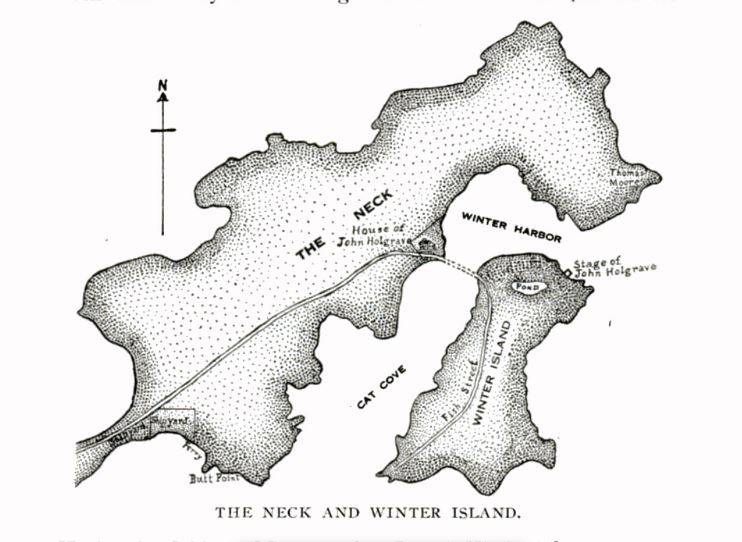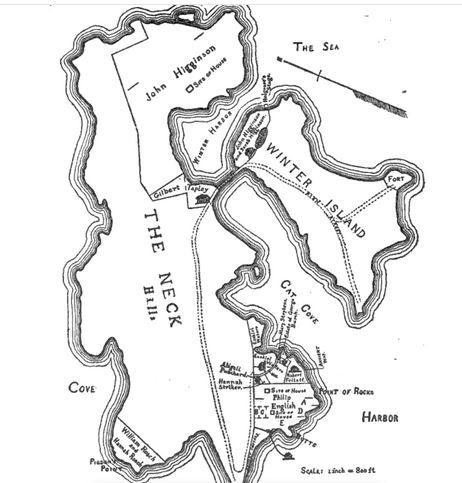Winter Island is an island connected by a causeway to Salem Neck in Salem, Massachusetts. The island is 38 acres in size, is ½ mile long and is located on the western side of Salem Harbor.
Prior to the arrival of the colonists in 1626, Winter Island was home to the local Native American tribe the Naumkeag.
After Salem was settled, Winter Island quickly became the center of the fishing industry in Salem after fishing stages were constructed on the island in 1629.
The island is believed to have gotten its name from Winter Harbor, which is a harbor on the island where the colonists stored their fishing vessels during the winter to protect them from storms.
The coves of Winter Island, Cat Cove and Abbott’s Cove, were much deeper than they are now and more abundant in fish and since the island was surrounded by water it was easier to dry fish out in the open without wild or domestic animals stealing the fish.
The fishermen didn’t live on Winter Island and instead lived nearby on Salem Neck. To make it easier for the fishermen to access the island, a causeway was constructed to the island.
Shortly after, a cut was made through the causeway to let boats pass, which was referred to as Mordecay’s cut due to the fact that colonist Mordecay Crawford lived near it.
In 1636, Salem began regulating its fishing industry by issuing land grants and fishing rights.
On April 18, 1636, local fisherman John Holgrave received a land grant from the town for three quarters of an acre of land on Winter Island to construct fish flakes, which were large racks used to dry fish on.
In 1643, Fort Pickering was first built on Winter Island but it wasn’t fully completed until the 1650s and was later rebuilt many times over the years.
In 1667, the town voted that the cut on the causeway should be filled in and a new causeway and bridge should be constructed.
In 1679, John Clifford was granted a license to run a tavern on Winter Island near Abbott’s Cove.
By 1684, around 10 colonists were authorized to build wharves on Winter Island which were constructed within the coves as well as on the Juniper Point side of Abbott’s Cove. The number of fish houses, flakes and warehouses also increased and there were about 40 fishing vessels on the island.
The fishing industry in Salem was directly tied to foreign trade. By 1700, dried codfish was in huge demand in Spain, Portugal and the Straits and refuse fish was sold in the West Indies while trade with England consisted of whale and fish oil.
The fishing industry on Winter Island thrived for over 100 years until 1740 when the demand for fish dramatically increased and larger vessels were needed to ship the catch to these foreign ports. As a result, the industry moved to other locations with deeper water and more space for larger ships.
Between 1772 and 1821, a small hill on the island, now known as Execution Hill, was used as an execution site in four hangings.
It’s not known exactly why the hill was chosen as an execution site but is probably because it was a rocky hill with a lot of open space around it that could accommodate the large crowds who attended these executions.
The prisoners were taken to the hill in a cart which also carried their coffin. They were made to stand on the cart while a noose was placed around their neck and then the cart was driven out from underneath them.
The first execution took place on the island on January 16, 1772, when 39-year-old convicted rapist Bryan Sheehan was hanged in front of a crowd of 12,000 people.
Also standing on the gallows that day was a man named George Penn who had been convicted of participating in a mob that attacked loyalist Jesse Seville in Gloucester in 1770. Penn had served two years in prison and had been sentenced to stand upon on the gallows with a noose around his neck for an hour before being whipped 20 times.
On December 21, 1786, a 39-year-old Native American man named Isaac Combs was hanged on Execution Hill for the murder of his wife.
On January 14, 1796, convicted robber and murderer Henry Blackburn was also hanged on Execution Hill.
The last execution took place on the hill on May 10, 1821, when 16-year-old Stephen Merrill Clark was executed for arson in front of a crowd of 20,000 people. After 1821, all executions were moved to the courtyard of the Salem jail on St. Peter Street.
In addition to serving as an execution site, the island was also temporarily used for shipbuilding. In 1799, a shipyard was constructed on the south side of Winter Island by Enos Briggs in order to build the Essex Frigate. Briggs’ main shipyard was in downtown Salem but he built the Essex on Winter Island because the water there was actually deep enough to accommodate the large warship.
During the 19th century, the island served as a camping ground for the Massachusetts volunteer militia. In August of 1853, the Second Division camped out on the island for three days, in an encampment called Camp Sutton. The division returned for another few days in 1855.
In September of 1856, the Fourth Brigade visited the island in an encampment called Camp Edmunds. In August of 1858, the Second Division returned again in an encampment called Camp Banks.
When the encampments were taking place, Salem Neck was lined with tents and shanties and a steady stream of soldiers and military vehicles could be seen traveling back and forth across the neck to the camp, creating dust clouds everywhere. Large crowds of spectators would also swarm the island hoping to view the encampment and listen to the marching bands. (Streeter 126)
In 1867, the portion of Winter Island not occupied by Fort Pickering was ceded by the federal government to the city of Salem.
On March 28, 1869, the city of Salem conveyed 35 acres of that land on Winter Island to the Plummer Farm School of Reform for Boys. The school opened in 1870 and its purpose was to serve as a reform school for delinquent or extremely disadvantaged and destitute boys through work and education.
In 1871, a lighthouse was constructed on the island and was named Winter Island Light, although it also sometimes referred to as Fort Pickering Light.
In 1935, the Coast Guard Air Station Salem was built on Winter Island. The station ran until 1970 when it was decommissioned and closed down.
In the 1950s, the Plummer Farm School became a group home for teenaged boys and was renamed the Plummer Home for Boys in 1958.
In 1972, ownership of Fort Pickering was returned to the city of Salem and it became a city park named Winter Island Marine Park.
The Winter Island Historic and Archaeological District was created and added to the National Register of Historic Places on April 14, 1994.
In 2000, Historic Salem Inc. included Winter Island on its “Most Endangered Properties” list.
In 2017, the former Plummer Farm School on Winter Island became Plummer Youth Promise, a nonprofit organization that connects young people in group or foster care with permanent families.
Sources:
Perley, Sidney. History of Salem Massachusetts. Volume I 1626 – 1637. Salem: 1924.
Streeter, Gilbert L. “The Story of Winter Island and Salem Neck.” Essex Institute Historical Collections Vol. XXXIII, Essex Institute, 1898, pp: 105 – 128
“Plummer Farm School Records.” Salem State University, archivesspace.salemstate.edu/repositories/2/resources/22
“Salem Reconnaissance Report.” Mass.gov, Massachusetts Department of Conservation and Recreation, mass.gov/doc/salem/download
“Winter Island: An Analysis of Resource Significance and Management Options.” NPS, npshistory.com/publications/sama/winter-island.pdf
Curley, Jerome. “A History of Winter Island, Salem’s Archaeological Treasure.” Patch, 29 June. 2012, patch.com/massachusetts/salem/winter-island-an-archaeological-treasure
“An Execution at Winter Island.” Streets of Salem, 10 May. 2011, streetsofsalem.com/2011/05/10/an-execution-at-winter-island/
“Did You Know…” City of Salem, salem.com/winter-island-park/pages/did-you-know
“Winter Island Historic and Archaeological District.” MACRIS, Massachusetts Cultural Resource Infoamtion System, Massachusetts Historical Commission, mhc-macris.net/Details.aspx?MhcId=SAL.IH



Very Interesting and informative piece. Thanks for writing it. Would it be possible to obtain your permission to have this article printed in as a brochure? Visitors to Winter Island come from all over the country and I know many would find this history fascinating.
Thanks,
Mary Ellen UNH 1977 Alumni
Yes, that’s fine with me. It’s nice to hear from a fellow UNH alum!